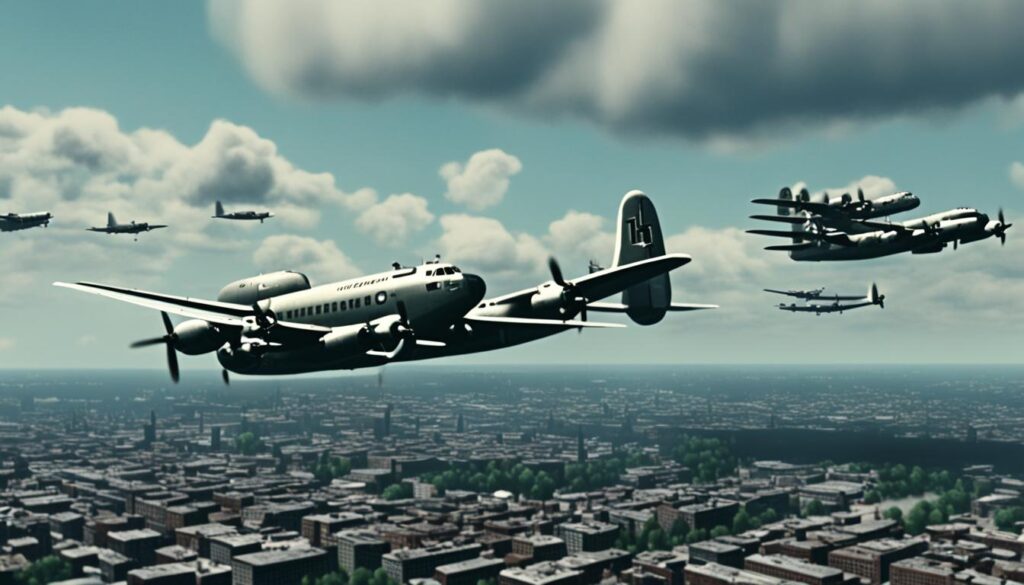The Berlin Airlift was a remarkable Cold War operation. It showed the Western Allies’ resolve against the Soviet blockade of West Berlin. The U.S. called it “Operation Vittles,” while the UK named it “Operation Plainfare.”
This massive undertaking began on June 26, 1948. Its goal was to supply the isolated city with essential goods.
The airlift’s efficiency and scale grew rapidly. At its peak, planes landed at Tempelhof Airport every 45 seconds. The number of aircraft increased over time.
By spring 1949, Operation Vittles was clearly successful. It proved that the Allies could sustain the airlift indefinitely. This made the Soviet blockade ineffective.
The Berlin Airlift ensured West Berlin’s survival. It became a powerful symbol of Western resolve during the Cold War.
Key Takeaways
- The Berlin Airlift, also known as “Operation Vittles” and “Operation Plainfare,” began on June 26, 1948, in response to the Soviet blockade of West Berlin during the Cold War.
- At the height of the airlift, planes landed at Tempelhof Airport every 45 seconds, showcasing the incredible efficiency and scale of the operation.
- The number of aircraft involved in the Berlin Airlift increased over time, demonstrating the Western Allies’ commitment to supplying West Berlin.
- By the spring of 1949, the success of the airlift had proven that the Western Allies could sustain the operation indefinitely, rendering the Soviet blockade ineffective.
- The Berlin Airlift not only ensured the survival of West Berlin but also served as a powerful symbol of the West’s resolve during the Cold War.
The Berlin Blockade: A Major Crisis of the Cold War
The Berlin Blockade was a key Cold War crisis. It lasted from June 24, 1948, to May 12, 1949. Soviet forces blocked Allied access to Berlin, which was in Soviet-controlled East Germany.
The U.S., UK, and France controlled western Berlin. Soviet troops controlled the eastern part. This split caused tensions between Western powers and the Soviet Union.
The blockade stemmed from different ideas about post-war Germany. Western Allies wanted to rebuild Germany’s economy. The Soviet Union aimed to get war reparations and create a communist state.
This crisis was the first direct Soviet challenge to Western Allies in Berlin. It aimed to force the West to give up their goals in Germany. The blockade also showed the growing split between East and West Germany.
Western Allies, led by the U.S., refused to give in. They organized a massive airlift to supply Berlin. The Berlin Airlift, or Operation Vittles, became a symbol of Western unity.
This airlift brought food, fuel, and other essentials to the city. It showed Western resolve against Soviet pressure during the early Cold War years.
Operation Vittles: The U.S. Response to the Blockade
The U.S. launched Operation Vittles on June 26, 1948, to counter the Soviet blockade of West Berlin. Major General Curtis E. LeMay led the U.S. Air Forces in Europe. They started with 102 C-47s and 2 C-54s for the Berlin Airlift.
C-47s could carry 3 tons each, while C-54s managed 10 tons per flight. Brigadier General Joseph Smith named it “Operation Vittles” as they were “hauling grub” to West Berliners.
Major General William H. Tunner later took command. He set up a system allowing planes to land every 3 minutes. This ensured a steady flow of supplies into the city.

Operation Vittles showed the U.S. military’s ingenuity and determination. The Berlin Airlift proved Western powers’ commitment to West Berlin’s freedom. It also stressed the need for better U.S.-Soviet communication during crises.
This led to the creation of the Washington-Moscow hotline. The hotline aimed to prevent misunderstandings that could spark a nuclear war.
Berlin Airlift Landing Frequency
The Berlin Airlift saw planes landing every 45 seconds at Tempelhof Airport. General William H. Tunner aimed for one landing per minute. This pace required unmatched precision and coordination in aviation history.
A strict system guided transports through air corridors at set times and altitudes. Radio beacons and ground radar controllers directed pilots. They followed instructions carefully to maintain speed and spacing between aircraft.
The airlift peaked on Easter Sunday, April 17, 1949, during the “Easter Parade.” That day, 13,000 tons of cargo arrived, including 600 railroad cars of coal. This showed the airlift’s efficiency and the staff’s dedication.
American planes delivered supplies to Tempelhof Airport. British aircraft landed at Gatow Airport. In October 1948, both efforts merged under one command. This improved coordination and boosted the airlift’s effectiveness.
The Legacy of the Berlin Airlift
The Berlin Airlift was a crucial event in the early Cold War. It lasted until September 30, 1949, after the Soviet Union lifted the blockade in May. The Western Allies delivered over 2.3 million tons of cargo on 278,228 flights.
The U.S. Air Force contributed 76.4% of the total cargo. The RAF delivered 23.3%. Canadian, Australian, New Zealand, and South African air crews also helped.
The airlift’s success came at a cost. 39 British and 31 American lives were lost, mostly due to non-flying accidents. There were also civilian casualties.
The airlift highlighted different visions for postwar Europe. It played a key role in aligning West Germany with the United States and Britain.
The Berlin Airlift’s impact went beyond resolving the immediate crisis. It led to the creation of NATO. It also helped incorporate West Germany into the Western bloc in 1955.
The airlift showed the West’s commitment to West Berlin’s people. It demonstrated their determination to counter Soviet aggression. This set the stage for the long Cold War standoff.
Today, the Berlin Airlift symbolizes human resilience and ingenuity. It shows the power of international teamwork in tough times. It reminds us to stand united against oppression, even in dark times.

Leave a Reply